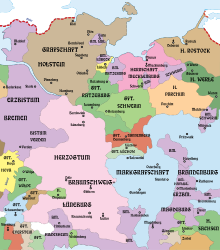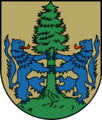Dannenberg County
|
|
|
|---|---|
| The county of Dannenberg (red area in the red circle) around 1250 |
The County of Dannenberg was a fiefdom in the Duchy of Saxony . The core area was largely identical to today's Elbtalaue municipality .
The historical origin lies in the middle of the 12th century, when Henry the Lion founded the five counties Holstein , Ratzeburg , Schwerin , Dannenberg and Lüchow during the eastern colonization from the mouth of the Elbe to the southern border on the Mark Brandenburg , around the new areas and Protect borders of his country.
The county of Dannenberg is mentioned for the first time in 1153, the first count was Volrad I von Dannenberg until 1169. His brother was Friedrich I. Vogt von Salzwedel, mentioned in a document in 1145, whose descendants were owners of the Grafschaft Gützkow from 1270 to 1359 . Both came from the noble family of nobles of Salzwedel . The end of the county can be dated to 1303, when the last count, Nikolaus von Dannenberg, left all his rights between Elbe and Jeetzel to Duke Otto the Strict , and 1311 with the last documentary mention.
history

At that time, farmers, craftsmen and tradespeople settled around the Grafenburg, the village of Dannenberg emerged , but the name Dannenberg already existed before that. From 1223 to 1225, King Waldemar II of Denmark was imprisoned with his son in the Count's castle tower ( Waldemarturm ), which has been preserved to this day , after Heinrich von Schwerin had brought them here. In 1237 the Counts Heinrich and Bernhard von Dannenberg had the Land of Lenzen from the Brandenburg Margraves Johann I and Otto III. to fiefdom. In the same year, the two counts granted the Lübeckers duty-free in their territory, namely Dannenberg, Dömitz and Lenzen. In 1303, the last count, Nikolaus von Dannenberg (documented from 1264 to 1311), left the county to the Duke of Braunschweig and Lüneburg Otto the Strict in return for an annuity of 40 marks a year . The former county has since belonged to the Principality of Lüneburg .
The office of Dannenberg goes back to the county . From 1569, this together with the Scharnebeck monastery formed the dominion of Dannenberg , with which Duke Heinrich had been resigned after his resignation from the principality of Lüneburg. However, the Dannenberg line did not achieve complete sovereignty, essential sovereign rights remained with the ducal house in Celle. In 1671 the Dannenberg rule fell back to the Guelph line in Celle. The office of Dannenberg opened in 1885 in the newly formed district of Dannenberg .
coat of arms
The county of Dannenberg had erect, partly single, partly facing lions in its coat of arms . Occasionally these were connected to a Christmas tree.
The earliest known seal of the county, showing a right-facing, ascending lion, dates back to 1215 and belonged to Volrad II. It is not known whether this symbol was supposed to express a relationship between the county and Henry the Lion. The rising lion is shown as a common figure in all coats of arms, which were repeatedly changed by the counts to distinguish one another. A fir tree as a further figure was added by Adolf I, Count zu Dannenberg from 1245. Two facing lions first appeared in the seal of Bernhard II, Count zu Dannenberg around 1283–1293.
The symbols of the Counts of Dannenberg have been preserved to the present day. Lions and fir trees are featured in the coat of arms of the city of Dannenberg (Elbe), the former joint municipality of Dannenberg (Elbe) and the former district of Dannenberg. The coat of arms of the Lüchow-Dannenberg district shows a fir tree next to the three diamonds of the former Lüchow county.
Tribe list
- Volrad I, from the house of the nobles von Salzwedel, brother of Friedrich von Salzwedel, first Count of Dannenberg, 1153–1166 Count zu Dannenberg, but presumably 1145–1169
- Heinrich I, 1169–1209 Count zu Dannenberg
- Volrad II, † probably in 1226 in battles against Waldemar II near Rendsburg , 1207–1226 Count zu Dannenberg; ∞ Jutta von Wölpe , third daughter of Count Bernhard II von Wölpe
- Heinrich III., 1233–1237 Count zu Dannenberg
- Heinrich II., 1203–1236 Count zu Dannenberg; ∞ daughter of Adolf III. from Holstein
- Bernhard I, † probably 1266/67, mentioned in a document as deceased in 1276, 1227–1266 Count zu Dannenberg; ∞ Countess of Schwerin
- Heinrich V, † before 1303, also referred to as Graf von Grabow , Graf zu Dannenberg around 1273–75
- Adolf II, † before 1303, also known as Count von Dömitz , Count zu Dannenberg around 1273
- Volrad IV., Last documented mention 1306
- Johann, † before 1306
- son
- Bernhard II., † before 1303, Count zu Dannenberg around 1283–1293
- Gunzel
- Nikolaus, Count of Dannenberg around 1289–1303, last Count of Dannenberg in 1303, last documented mention in 1311
- Daughter; ∞ Johann Gans zu Putlitz
- Adolf I, † 1266/67, 1245–1266 Count of Dannenberg; ∞ Mathilde, † around 1259
- Volrad III.
- Friedrich, Count zu Dannenberg around 1274–1285
- Bernhard III.
- Daughter; ∞ Helmhold III. from Schwerin
- Mathilde, nun in the St. Lorenz Monastery in Magdeburg
- daughter
- Henry IV, Canon
- Gerburge
- Sophie
- Bernhard I, † probably 1266/67, mentioned in a document as deceased in 1276, 1227–1266 Count zu Dannenberg; ∞ Countess of Schwerin
- Volrad II, † probably in 1226 in battles against Waldemar II near Rendsburg , 1207–1226 Count zu Dannenberg; ∞ Jutta von Wölpe , third daughter of Count Bernhard II von Wölpe
- Heinrich I, 1169–1209 Count zu Dannenberg
See also
literature
- Wilhelm Meyer: History of the counts of Ratzeburg and Dannenberg . Schwerin 1911. In: Yearbook of the Association for Mecklenburg History and Archeology . Volume 76.Bearensprungsche Hofbuchdruckerei, Schwerin 1911.
- Berndt Wachter : From Dannenberg and its history. 2nd Edition. Becker Verlag, Uelzen 1983, DNB 840371519 .
- Wolfgang Juerries , Berndt Wachter (Ed.): Dannenberg, Count of in: Wendland-Lexikon . Volume 1: A – K, 2nd edition. Druck- und Verlagsgesellschaft Köhring & Co., Lüchow 2008, ISBN 978-3-926322-28-9 , pp. 143-143.
Individual evidence
- ↑ Gehrcke: The Counts of Lüchow. In: Chronicle of the City of Lüchow. E. Koehring. Lüchow 1949, pp. 10-21.
- ↑ Lieselott Enders : The Prignitz story of a Kurmärkischen landscape from the 12th to the 18th century. (Series of publications: Publications of the Brandenburg State Main Archives Volume 38). Publishing house for Berlin-Brandenburg, Potsdam 2000 ISBN 3-935035-00-4 .
- ↑ Adolph Friedrich Johann Riedel : Codex Diplomaticus Brandenburgensis Collection of documents, chronicles and other sources for the history of the Mark Brandenburg and its rulers. A. First main part or collection of documents for local and special regional history, Volume 3. 512 p., Berlin, FH Morin 1843 Online at Google Books (Document No. VI (= 6), p. 341)
- ^ Ernst Saß: On the genealogy of the Counts of Dannenberg. In: Yearbooks of the Association for Mecklenburg History and Archeology. Volume 43, 1878, pp. 33-164, here in particular: p. 139, Stammtafel (online). ( Memento of the original from July 16, 2010 in the Internet Archive ) Info: The archive link was inserted automatically and has not yet been checked. Please check the original and archive link according to the instructions and then remove this notice.
- ↑ Berndt Wachter: From Dannenberg and its history. 2nd Edition. Becker Verlag, Uelzen 1983, pp. 15-23.
- ↑ Samtgemeinde Elbtalaue - City History of Dannenberg ( Memento of the original from September 28, 2007 in the Internet Archive ) Info: The archive link was inserted automatically and has not yet been checked. Please check the original and archive link according to the instructions and then remove this notice.
-
^ For the history of the Dannenberg rule see: Manfred von Boetticher: Geschichte Niedersachsens. Volume 3, Part 1: Politics, Economy and Society from the Reformation to the beginning of the 19th century. Hannover 1998, ISBN 3-7752-5901-5 , pp. 15-351, here pp. 72-76.
For the office of Dannenberg see: Martin Krieg: The origin and development of the administrative districts in the former principality of Lüneburg. Göttingen 1922, pp. 61-65. - ↑ Lüchow-Dannenberg district - information on the district coat of arms ( memento of the original dated October 23, 2007 in the Internet Archive ) Info: The archive link was automatically inserted and not yet checked. Please check the original and archive link according to the instructions and then remove this notice.






